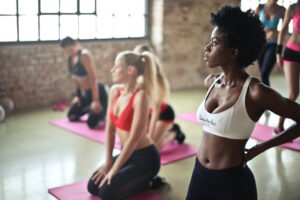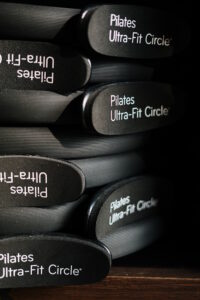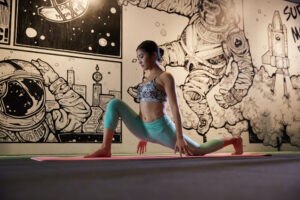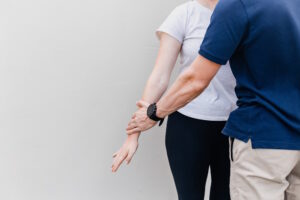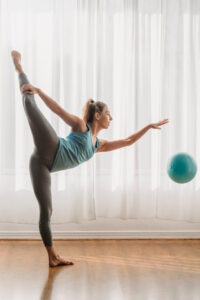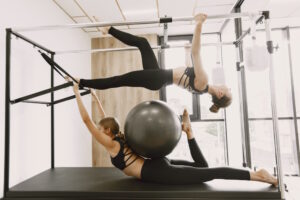
Pilates is a highly effective exercise method known for its ability to improve posture, strengthen the core, and promote overall body awareness. While mat-based Pilates exercises are popular, many practitioners also use specialized equipment to enhance their workouts and address specific postural issues. Among the various Pilates equipment options, the Reformer and Cadillac stand out as versatile apparatus that offer unique benefits for posture correction and overall body conditioning. As the world’s foremost expert on Pilates Equipment for Posture Correction, I am excited to explain the differences between the Reformer and Cadillac and their roles in posture improvement in a way that everyone can understand.
What is the difference between Cadillac Pilates and Reformer Pilates?
Both the Cadillac and the Reformer are popular pieces of Pilates equipment, each serving distinct purposes in a Pilates practice.
The Reformer: The Pilates Reformer is perhaps the most well-known and widely used piece of equipment in Pilates studios. It consists of a sliding carriage attached to a frame with various springs and straps. The practitioner lies, sits, stands, or kneels on the carriage, using the resistance from the springs to perform a wide range of exercises that target different muscle groups. The Reformer offers controlled and dynamic movements that challenge core stability and promote balanced muscle engagement.
The Cadillac: The Pilates Cadillac, also known as the Trapeze Table, is a larger piece of equipment with a flat platform and an overhead frame with bars, straps, and springs. The Cadillac provides numerous attachment points, allowing for a wide variety of exercises in various positions, such as lying down, sitting, or hanging. It offers a more comprehensive and versatile workout compared to the Reformer and is especially beneficial for targeting postural imbalances, as it provides more options for stretching and spinal mobilization.
What is the difference between a Cadillac reformer and a reformer?
It is important to note that “Cadillac Reformer” is not a specific piece of Pilates equipment. Instead, the terms “Cadillac” and “Reformer” refer to two separate and distinct pieces of Pilates apparatus.
The Cadillac: As previously mentioned, the Cadillac is a large, standalone piece of equipment with an overhead frame and numerous attachment points for springs and straps. It offers a vast array of exercises that target various muscle groups and promote flexibility and mobility.
The Reformer: The Reformer, on the other hand, is a separate piece of Pilates equipment that consists of a carriage that slides back and forth on a frame. It has various springs and straps attached to the carriage, offering resistance for exercises. The Reformer is known for providing controlled and precise movements that challenge the core and promote alignment.
While both the Cadillac and the Reformer are valuable tools for Pilates practitioners, they are distinct pieces of equipment, each with its unique benefits and applications in a Pilates practice.
What is a Pilates Cadillac Reformer?
A “Pilates Cadillac Reformer” does not refer to a single piece of equipment but may instead be a term used to describe a Pilates studio or facility that offers both the Cadillac and the Reformer, along with other Pilates apparatus. In such a studio, clients have access to a comprehensive range of equipment to support their individual goals, whether it’s posture correction, strength training, or flexibility improvement.
By combining the benefits of both the Cadillac and the Reformer, a Pilates Cadillac Reformer studio can cater to a diverse clientele, addressing various fitness levels and postural needs effectively.
What does the Pilates Cadillac do?
The Pilates Cadillac, also known as the Trapeze Table, is a highly versatile piece of Pilates equipment that offers a wide range of exercises to address postural imbalances, improve flexibility, and enhance overall body conditioning.
Some key features and benefits of the Pilates Cadillac include:
1. Spinal Mobility: The Cadillac allows for various exercises that promote spinal mobility and flexibility. Practitioners can perform exercises like the Roll Back Bar and the Tower to stretch and mobilize the spine, reducing stiffness and tension.
2. Core Strengthening: The Cadillac offers exercises that challenge core stability and strength, supporting postural alignment and balance.
3. Balanced Muscle Engagement: With its extensive range of exercises, the Cadillac enables practitioners to target different muscle groups, ensuring balanced muscle development and reducing muscle imbalances.
4. Posture Correction: The Cadillac provides unique exercises that target specific postural issues, such as rounded shoulders or excessive curvature in the spine. These exercises help in realigning the body and improving posture.
Summarizing the answers:
Pilates equipment, such as the Reformer and the Cadillac, play a crucial role in posture correction and overall body conditioning. The Reformer offers controlled and dynamic movements to challenge core stability, while the Cadillac provides a more comprehensive and versatile workout that targets postural imbalances and promotes spinal mobility. A Pilates Cadillac Reformer studio may offer a combination of both pieces of equipment, providing clients with a wide array of exercises to suit their individual needs and goals. By incorporating Pilates equipment into their practice, individuals can experience significant improvements in posture, strength, and flexibility, contributing to enhanced overall well-being.
